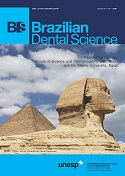Evaluation of the golden proportion and golden standard of maxillary anterior teeth in relation to smile attractiveness
DOI:
https://doi.org/10.14295/bds.2019.v22i2.1694Abstract
Objective: The present study aimed to explore the existence of golden proportion (GP) between the widths of maxillary anterior teeth and golden standard (GS) for width to height ratio of maxillary central incisor in individuals with attractive and non-attractive smiles. Material and Methods: A total 82 females were recruited and divided into 2 groups: attractive smile (n=41) and non-attractive smile (n=41). Frontal photographs were taken, scanned, and saved in a personal computer. The apparent mesiodistal width of each anterior tooth was measured. The data were analyzed using the appropriate statistical tests at a P-value of <0.05. Results: Frequency of GP was very low among the total sample, and most proportions were higher than GP. No significant differences were found between both groups in relation to central-to-lateral ratio while, significant differences were found in relation to canine-to-lateral ratio. Similarly, most proportions of width to height ratio were higher than GS. Differences between groups were significant for the left side and for both sides (P<0.05) but was not for the right side (P>0.05). Conclusion: Frequency of the golden proportion was very low among the study population. Smile attractiveness was not greatly related to the proportions between the teeth.
Keywords
Golden proportion; Golden standard; Attractive smile; Esthetic; Anterior teeth.
Downloads
Downloads
Additional Files
Published
How to Cite
Issue
Section
License
Brazilian Dental Science uses the Creative Commons (CC-BY 4.0) license, thus preserving the integrity of articles in an open access environment. The journal allows the author to retain publishing rights without restrictions.
=================




























